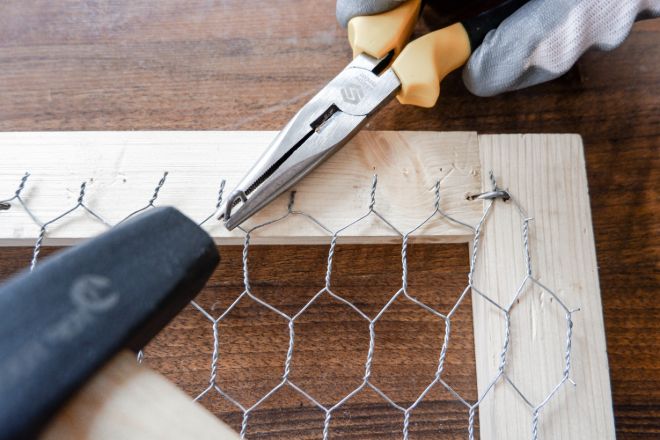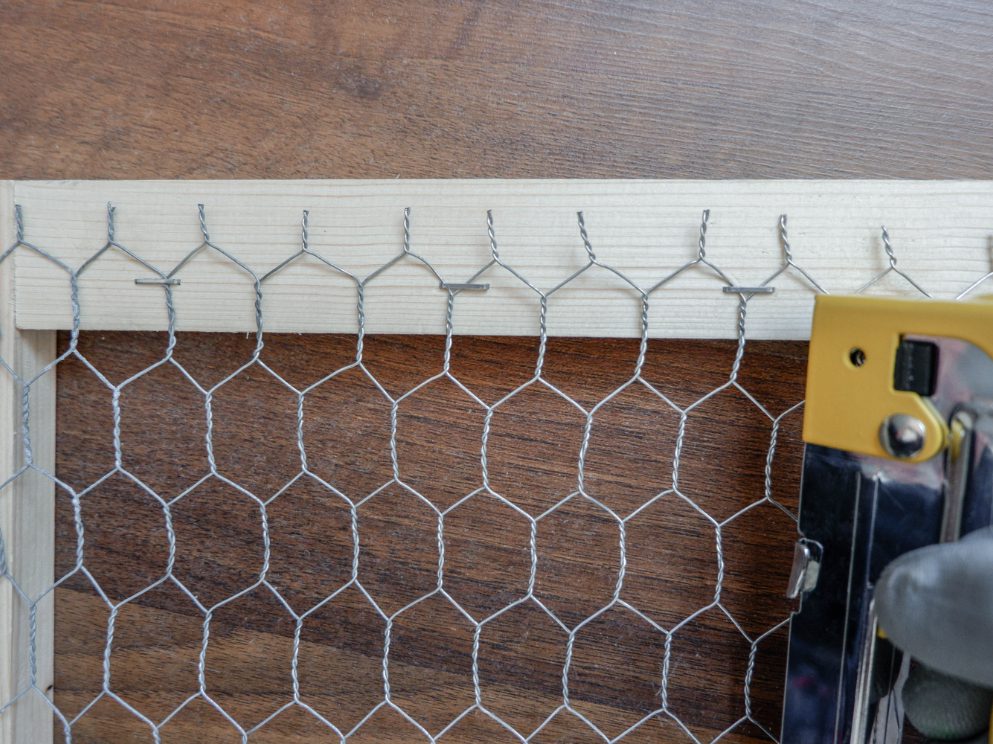To secure chicken wire to wood, use staples or nails spaced about six inches apart. Ensure the wire is taut for stability.
Chicken wire is a versatile fencing material, commonly used for gardens, chicken coops, and enclosures. Properly securing it to wood ensures durability and prevents unwanted animals from entering. Many people choose chicken wire for its affordability and ease of installation.
Whether you’re building a small garden fence or a larger animal enclosure, following correct techniques is essential for longevity. The right tools and materials can make the process efficient and straightforward. This guide will provide step-by-step instructions on how to effectively attach chicken wire to wood, ensuring a secure and functional barrier for your needs.

Credit: www.wirefence.co.uk
How to Secure Chicken Wire to Wood : Step by Step Guide
Introduction To Chicken Wire Projects
Chicken wire is a great choice for many projects. It is strong and flexible. This material is perfect for securing pets or creating garden fences.
Using chicken wire is cost-effective. It allows for good airflow while keeping animals out. This makes it ideal for gardens and coops.
Choosing the right wood is important. Look for sturdy options like cedar or pine. These types resist rot and can handle weather changes well.
Consider the thickness of the wood. Thicker wood provides better support for the chicken wire. This ensures a longer-lasting installation.
Essential Tools And Materials
To secure chicken wire to wood, gather the right tools. Essential tools include:
- Chicken wire – Choose a quality type for durability.
- Staple gun – This helps attach the wire easily.
- Wood screws – Ensure strong connections to the wood.
- Hammer – Use it for driving in the staples.
- Pliers – Handy for cutting and bending the wire.
- Measuring tape – Measure accurately before cutting.
- Safety gloves – Protect your hands while working.
Selecting quality chicken wire is very important. Look for wire with a strong gauge. This ensures it lasts longer and withstands weather. A good wire also prevents animals from breaking in.
Preparation Steps
Start by measuring the area where the chicken wire will go. Use a tape measure for accuracy. Mark the measurements on the wood with a pencil. Cut the wood to the correct size using a saw.
Next, cut the chicken wire to fit the wood. Lay the wire flat on the ground. Use the measured wood as a guide. Cut the wire with wire cutters. Ensure the wire is slightly larger than the wood.

Credit: stowandtellu.com
Attaching Chicken Wire To Wood Frames
To attach chicken wire to wood frames, first lay out the wire. Cut the wire to fit the frame, leaving extra material for securing. Make sure the wire is taut for the best results.
Using staples or nails is a great way to secure the wire. Place staples every few inches along the edges. Ensure they are driven in firmly to hold the wire tightly. If using nails, space them evenly for strong support.
Tips For A Tight And Secure Fit
To achieve a tight and secure fit for chicken wire on wood, use tension wisely. Pull the wire tightly before securing it. This prevents sagging and ensures durability.
Spot-checking for gaps is crucial. Walk around the perimeter and inspect for any loose areas. Use your hands to press against the wire. This helps identify weak spots.
When you find gaps, adjust the wire accordingly. Use staples or nails to secure the wire more firmly. Ensure that all edges are well-fastened.
Regularly check the wire over time. Weather changes can impact its tightness. Keeping an eye on it helps maintain its integrity and effectiveness.
Safety Considerations
Using chicken wire can be safe with proper care. Always handle it gently. Sharp edges can cause cuts. Use caution when moving the wire.
Wearing protective gear is very important. Use gloves to protect your hands. Safety glasses can keep your eyes safe. A long-sleeved shirt can help too. Make sure to stay alert while working.
Creative Uses For Chicken Wire And Wood
Chicken wire is great for garden fencing. It keeps animals out while allowing air and sunlight in. Use it to protect your plants from pests. This wire is easy to cut and shape, making it perfect for custom fencing.
For decorative projects, chicken wire adds a unique touch. Create artistic wall displays or hanging planters. The wire can hold plants or flowers beautifully. It works well in craft projects, too, like making shapes or frames.
Secure chicken wire to wood using staples or nails. This keeps the wire tight and sturdy. Choose rust-resistant materials for outdoor projects. With creativity, chicken wire and wood can enhance any space.
Maintenance And Repairs
Regular check-ups are essential for keeping chicken wire secure. Inspect the wire for any signs of wear. Look for rust, holes, or loose sections. Fixing these issues early prevents bigger problems later.
Repairing damage should be done quickly. Use wire cutters to remove the damaged section. Cut a new piece of chicken wire to size. Secure the new wire using staples or nails. Ensure the wire is tight against the wood.
| Task | Frequency |
|---|---|
| Visual Inspection | Every Month |
| Rust Treatment | As Needed |
| Wire Repair | Immediately After Damage |

Credit: www.youtube.com
Frequently Asked Questions
How Do You Attach Chicken Wire To Wood?
To attach chicken wire to wood, first, cut the wire to the desired size. Use a staple gun or nails to secure it tightly against the wood. Ensure the wire is taut to prevent sagging. For added security, use fence staples for better anchoring.
What Tools Do I Need For Chicken Wire Installation?
You’ll need several tools for chicken wire installation. A staple gun or hammer and nails are essential. Wire cutters help in trimming the wire accurately. Additionally, gloves protect your hands from sharp edges. A measuring tape ensures proper sizing for your project.
Can I Use Screws Instead Of Staples?
Yes, you can use screws to secure chicken wire. Choose screws with large washers to prevent pulling through the wire. This method may offer a stronger hold compared to staples. However, ensure the screws are not too long to avoid damaging the wood.
How Do I Prevent Rust On Chicken Wire?
To prevent rust on chicken wire, consider using galvanized wire. This type is coated to resist corrosion. If using non-galvanized wire, apply a protective coating of paint or sealant. Regular maintenance and inspection can also help prolong the wire’s lifespan.
Conclusion
Securing chicken wire to wood is essential for effective animal enclosures. Following the right techniques ensures durability and safety. Remember to use quality materials and proper tools. This will help you achieve a stable setup. With these tips, you can confidently protect your garden or livestock for years to come.

